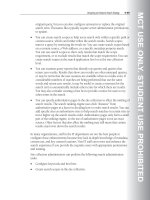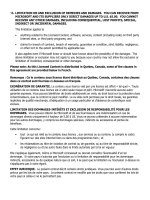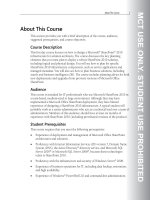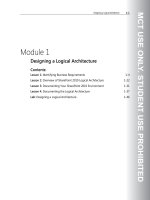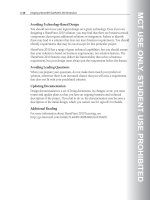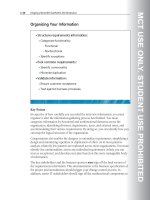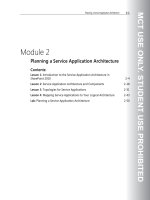Designing a Microsoft SharePoint 2010 Infrastructure Vol 1 part 47 ppt
Bạn đang xem bản rút gọn của tài liệu. Xem và tải ngay bản đầy đủ của tài liệu tại đây (1.46 MB, 10 trang )
MCT USE ONLY. STUDENT USE PROHIBITED
Designing an Enterprise Search Strategy 9-19
Lesson 2
Search Topologies in SharePoint 2010
When you plan search for a SharePoint farm, various topology options are
available to you. Before you size your search environment, you should be aware of
which search components you require, and how you can scale search components
to meet the needs of your users and content repositories.
Objectives
After completing this lesson, you will be able to:
• Identify options for SharePoint search topologies.
• Scale out index components in a SharePoint farm.
• Scale out query components in a SharePoint farm.
• Identify options for FAST search topologies.
MCT USE ONLY. STUDENT USE PROHIBITED
9-20 Designing a Microsoft® SharePoint® 2010 Infrastructure
SharePoint Search Topology
Key Points
In a SharePoint farm, you can specify the number of SharePoint servers that will
perform the index and query roles independently. You can implement multiple
servers for index or query roles, and you can split the index into partitions for
reasons of high availability or performance:
• In a small, two-tier farm environment, you may start with a mix of query and
index roles on one server. However, one of the first aspects to consider for
performance purposes is to separate the query and index roles.
• In a small, three-tier farm environment, the query role typically runs on the
WFE server and the index role runs on the application server. In this
environment, you could also add an additional database server for search
databases to help improve search performance.
• In a medium farm (or a small farm where you consider search to be critical),
you can assign the query role to multiple servers to improve query
performance or to provide high availability for the query role. You can also
assign multiple servers to host the crawl role so that you can improve crawl
times and provide high availability to the crawl role. As farm size increases, you
MCT USE ONLY. STUDENT USE PROHIBITED
Designing an Enterprise Search Strategy 9-21
can add additional servers to host the query or crawl roles to further improve
query responses or index freshness.
• In large farms, you can dedicate several servers to search roles, with multiple
dedicated query servers to improve query response times and multiple
dedicated crawl servers to improve crawl speeds.
MCT USE ONLY. STUDENT USE PROHIBITED
9-22 Designing a Microsoft® SharePoint® 2010 Infrastructure
Scaling Out Index Servers
Key Points
The search architecture in SharePoint 2010 is highly scalable, so you can support
indexing a corpus of up to 100 million items. To achieve this scaling, you can add
multiple index servers to the farm that is performing the crawl and hosting the
index. Scaling out index components can also improve crawl times and provide a
fresher index for users to search.
You can scale out the index mechanism in a farm by adding new crawl
components to existing crawl databases or adding new crawl components with
new crawl databases:
• The crawl component connects to the content source and crawls the content,
creating or updating a temporary index. This index is propagated
automatically to query servers in the farm.
• The crawl database holds information about crawl status, crawl items, and
crawl history.
MCT USE ONLY. STUDENT USE PROHIBITED
Designing an Enterprise Search Strategy 9-23
You can add more crawl components on additional servers by using an existing
crawl database to achieve high availability and a performance improvement for the
crawl process.
You can add a crawl database to distribute the crawl load between different servers
in the farm. Adding a crawl database requires you to add a crawl component
because you can only map crawl components to one crawl database.
When the farm contains multiple crawl databases, SharePoint attempts to balance
the crawl load between the databases, based on the host headers that the Web
applications are using. For example, suppose that you create two crawl databases
(with associated crawl components) and you have two Web applications in your
farm that have the host headers intranet.contoso.com and extranet.contoso.com.
SharePoint will use one crawl database for intranet.contoso.com and the other
crawl database for extranet.contoso.com.
You can also use host distribution rules to control which databases and crawler
components SharePoint uses to crawl which hosts. This is useful where you want
to control which crawl component and which server SharePoint uses to crawl
larger content sources, or if you want to group several small sources together.
MCT USE ONLY. STUDENT USE PROHIBITED
9-24 Designing a Microsoft® SharePoint® 2010 Infrastructure
Scaling Out Query Servers
Key Points
To scale query functionality, you must understand the individual components that
queries use. The following table lists the query components.
Component Description
Index partition Unlike previous versions of SharePoint 2010, the index is now only
stored on query servers. You can divide the index into parts called
index partitions. An index partition contains part of or the entire
index.
Query
component
Query components map to index partitions and property databases.
You can create additional query components for an existing index
partition. These mirror query components provide fault tolerance
for executing search queries.
You can also create additional index partitions to break down the
index into smaller parts for distributing across multiple servers. Each
index partition requires an associated query component. This can
help to reduce query latency (how long a query takes to execute).
MCT USE ONLY. STUDENT USE PROHIBITED
Designing an Enterprise Search Strategy 9-25
Component Description
Property
database
The property database holds information such as metadata, which a
search query must include when it executes a search. You can create
additional property databases to improve query performance, but a
query component must hold a mapping to a unique property
database.
In practice, this means that creating an additional property
database requires you to create an additional index partition with a
unique query component. However, creating an additional index
partition does not require you to create an additional property
database.
Query processor The query processor runs under the w3wp.exe process. It executes
each search query, retrieves search results from the property
database and the query components, packages the results, and
delivers the results back to the requesting WFE server.
The query processor queries a copy of each index partition and
property database for results. If multiple mirrors of an index
partition exist, the query processor load-balances requests between
different index partition mirrors.
The query processor can run on any server.
To provide fault tolerance, you can create mirrors of an index partition on
additional servers. To reduce query latency, you can create index partitions on
additional servers. You can also mix these options by adding servers to the farm
and provisioning mirrors of multiple index partitions so that you provide fault
tolerance and performance improvements.
MCT USE ONLY. STUDENT USE PROHIBITED
9-26 Designing a Microsoft® SharePoint® 2010 Infrastructure
FAST Search Topology
Key Points
If you plan to deploy FAST search for SharePoint 2010, you must plan the number
of FAST search servers and the FAST search topology to follow.
FAST search works on similar principles to SharePoint search. FAST search uses
separate index and query components, and similar scale-out mechanisms for the
purposes of fault tolerance or performance.
FAST search scaling works with the principle of rows and columns:
• An index column represents part of or the entire searchable index. You can
break the index into multiple columns if the index becomes too large to
manage as a single entity. A single index column should contain no more than
15 million items with the default configuration.
• A search row represents a set of search nodes that contain the entire index. A
search row consists of one search node for each index column. You can deploy
additional search rows (with corresponding search nodes) to provide
improvements to fault tolerance or query performance.
MCT USE ONLY. STUDENT USE PROHIBITED
Designing an Enterprise Search Strategy 9-27
Note: You can also create additional index rows, such as a backup index row, in addition
to the primary index row for fault tolerance in the index process. However, this does not
improve crawl performance.
MCT USE ONLY. STUDENT USE PROHIBITED
9-28 Designing a Microsoft® SharePoint® 2010 Infrastructure
Lesson 3
Capacity and Performance Planning for Search
When you understand how you can scale out search components, you can start
planning the quantity of storage that search components require and the number
of servers that search requires. You can use several calculations to provide an
estimate of the search storage requirements. However, the index and query
components often require performance testing to establish crawl times for a
content source, or query response times for users. Under these circumstances, you
can plan options for index or query components to bring the search performance
in line with business requirements. In addition, if you deploy FAST search, the
component sizing behaves differently, so sizing a FAST search deployment is
different to sizing a SharePoint search deployment.
Objectives
After completing this lesson, you will be able to:
• Plan capacity for SharePoint search.
• Improve index performance.
